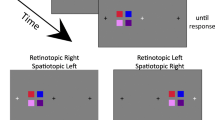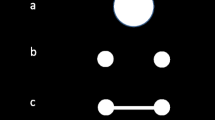Abstract
Observers encoded the spatial arrangement of two or three horizontal line segments relative to a square frame presented for 150 ms either in left or right visual field and either above or below the horizontal midline. The target pattern was selected on the basis of colour (red vs. green) from an equivalent distractor pattern in the opposite left–right visual hemifield. After a retention interval of 450 or 650 ms a test pattern was presented at fixation. The task was to decide whether the test was the same as the encoded pattern or different. Selection of the to-be-memorised pattern produced an N2pc response that was not influenced by the number of line segments nor by the length of the retention interval, but that was smaller in amplitude for patterns presented in the upper visual field compared with patterns presented in the lower visual field. A sustained posterior contralateral negativity (SPCN) followed the N2pc. The SPCN was larger for patterns with three line segments than for two, was larger for patterns encoded from lower visual field than from upper visual field, and returned to baseline sooner for the shorter retention interval than for the longer interval. These results, and others, provide an interesting and complex pattern of similarities and differences between the N2pc and SPCN, consistent with the view that N2pc reflects mechanisms of attentional selection whereas the SPCN reflects maintenance in visual short-term memory.





Similar content being viewed by others
References
Brisson, B., & Jolicœur, P. (2007a). Electrophysiological evidence of central interference in the control of visuospatial attention. Psychonomic Bulletin & Review, 14, 126–132.
Brisson, B., & Jolicœur, P. (2007b). A psychological refractory period in access to visual short-term memory and the deployment of visual-spatial attention: Multitasking processing deficits revealed by event-related potentials. Psychophysiology, 44, 323–333.
Dell’Acqua, R., Sessa, P., Jolicœur, P., & Robitaille, N. (2006). Spatial attention freezes during the attention blink. Psychophysiology, 43, 394–400.
Eimer, M. (1996). The N2pc component as an indicator of attentional selectivity. Electroencephalography and Clinical Neurophysiology, 99, 225–234.
Gratton, G., Coles, M. G. H., & Donchin, E. (1983). A new method for off-line removal of ocular artifacts. Electroencephalography and Clinical Neurophysiology, 55, 468–484.
He, S., Cavanagh, P., & Intriligator, J. (1996). Attentional resolution and the locus of visual awareness. Nature, 383, 334–337.
Hillyard, S. A., & Galambos, R. (1970). Eye movement artifact in the CNV. Electroencephalography and Clinical Neurophysiology, 28, 173–182.
Hickey, C., McDonald, J., & Theeuwes, J. (2006). Electrophysiological evidence of the capture of visual attention. Journal of Cognitive Neuroscience, 18, 604–613.
Jolicœur, P., Brisson, B., & Robitaille, N. (2008). Dissociation of the N2pc and sustained posterior contralateral negativity in a choice response task. Brain Research, 1215, 160–172.
Jolicœur, P., Sessa, P., Dell’acqua, R., & Robitaille, N. (2006a). Attentional control and capture in the attentional blink paradigm: Evidence from human electrophysiology. Psychological Research, 19, 560–578.
Jolicœur, P., Sessa, P., Dell’Acqua, R., & Robitaille, N. (2006b). On the control of visual spatial attention: Evidence from human electrophysiology. Psychological Research, 70, 414–424.
Kandel, E. R., Schwartz, J. H., & Jessell, T. M. (2000). Principles of neural science (4th ed.). New York: McGraw-Hill.
Kiesel, A., Miller, J., Jolicœur, P., & Brisson, B. (2008). Measurement of ERP latency differences: A comparison of single-participant and jackknife-based scoring methods. Psychophysiology, 45, 250–274.
Kiss, M., Jolicœur, P., Dell’Acqua, R., & Eimer, M. (2008). Attentional capture by visual singletons is mediated by top-down task set: New evidence from the N2pc component. Psychophysiology, 45, 1013–1024.
Klaver, P., Talsma, D., Wijers, A. A., Heinze, H.-J., & Mulder, G. (1999). An event-related brain potential correlate of visual short-term memory. NeuroReport, 10, 2001–2005.
Leblanc, É., Prime, D., & Jolicœur, P. (2008). Tracking the location of visuospatial attention in a contingent capture paradigm. Journal of Cognitive Neuroscience, 20, 657–671.
Lins, O. G., Picton, T. W., Berg, P., & Scherg, M. (1993). Ocular artifacts in EEG and event-related potentials 1: Scalp topography. Brain Topography, 6, 51–63.
Luck, S. J. (2005). An introduction to the event-related potential technique. Cambridge, MA: The MIT Press.
Luck, S. J., Girelli, M., McDermott, M. T., & Ford, M. A. (1997). Bridging the gap between monkey neurophysiology and human perception: An ambiguity resolution theory of visual selective attention. Cognitive Psychology, 33, 64–87.
Luck, S. J., & Hillyard, S. A. (1994a). Electrophysiological correlates of feature analysis during visual search. Psychophysiology, 31, 291–308.
Luck, S. J., & Hillyard, S. A. (1994b). Spatial filtering during visual search: Evidence from human electrophysiology. Journal of Experimental Psychology: Human Perception and Performance, 20, 1000–1014.
Maunsell, J. H. R., & Newsome, W. T. (1987). Visual processing in monkey extrastriate cortex. Annual Reviews of Neuroscience, 10, 363–401.
McCollough, A. W., Machizawa, M. G., & Vogel, E. K. (2007). Electrophysiological measures of maintaining representations in visual working memory. Cortex, 43, 77–94.
Miller, J., Paterson, T., & Ulrich, R. (1998). Jackknife-based method for measuring LRP onset latency differences. Psychophysiology, 35, 99–115.
Robitaille, N., & Jolicœur, P. (2006). Fundamental properties of the N2pc as an index of spatial attention: Effects of masking. Canadian Journal of Experimental Psychology, 60, 101–111.
Robitaille, N., Jolicœur, P., Dell’Acqua, R., & Sessa, P. (2007). Short-term consolidation of visual patterns interferes with visuo-spatial attention: Converging evidence from human electrophysiology. Brain Research, 1185, 158–169.
Sereno, M. I., Dale, A. M., Reppas, J. B., Kwong, K. K., Belliveau, J. W., Brady, T. J., et al. (1995). Borders of multiple visual areas in humans revealed by functional magnetic resonance imaging. Science, 268, 889–893.
Ulrich, R., & Miller, J. (2001). Using the jackknife-based scoring method for measuring LRP onset effects in factorial designs. Psychophysiology, 38, 816–827.
Vogel, E. K., & Machizawa, M. G. (2004). Neural activity predicts individual differences in visual working memory capacity. Nature, 428, 748–751.
Woodman, G. F., & Luck, S. J. (2003). Serial deployment of attention during visual search. Journal of Experimental Psychology: Human Perception & Performance, 29, 121–138.
Wyszecki, G., & Stiles, W. S. (1982). Color Science: Concepts and methods, quantitative data and formulae (2nd ed.). New York: Wiley.
Acknowledgments
This research was supported by research grants from the Natural Sciences and Engineering Research Council of Canada, The Canadian Institutes of Health Research, the Canadian Research Chair program, and by an infrastructure grant from the Fonds de Recherche en Santé du Québec to the last author.
Author information
Authors and Affiliations
Corresponding author
Rights and permissions
About this article
Cite this article
Perron, R., Lefebvre, C., Robitaille, N. et al. Attentional and anatomical considerations for the representation of simple stimuli in visual short-term memory: evidence from human electrophysiology. Psychological Research 73, 222–232 (2009). https://doi.org/10.1007/s00426-008-0214-y
Received:
Accepted:
Published:
Issue Date:
DOI: https://doi.org/10.1007/s00426-008-0214-y




